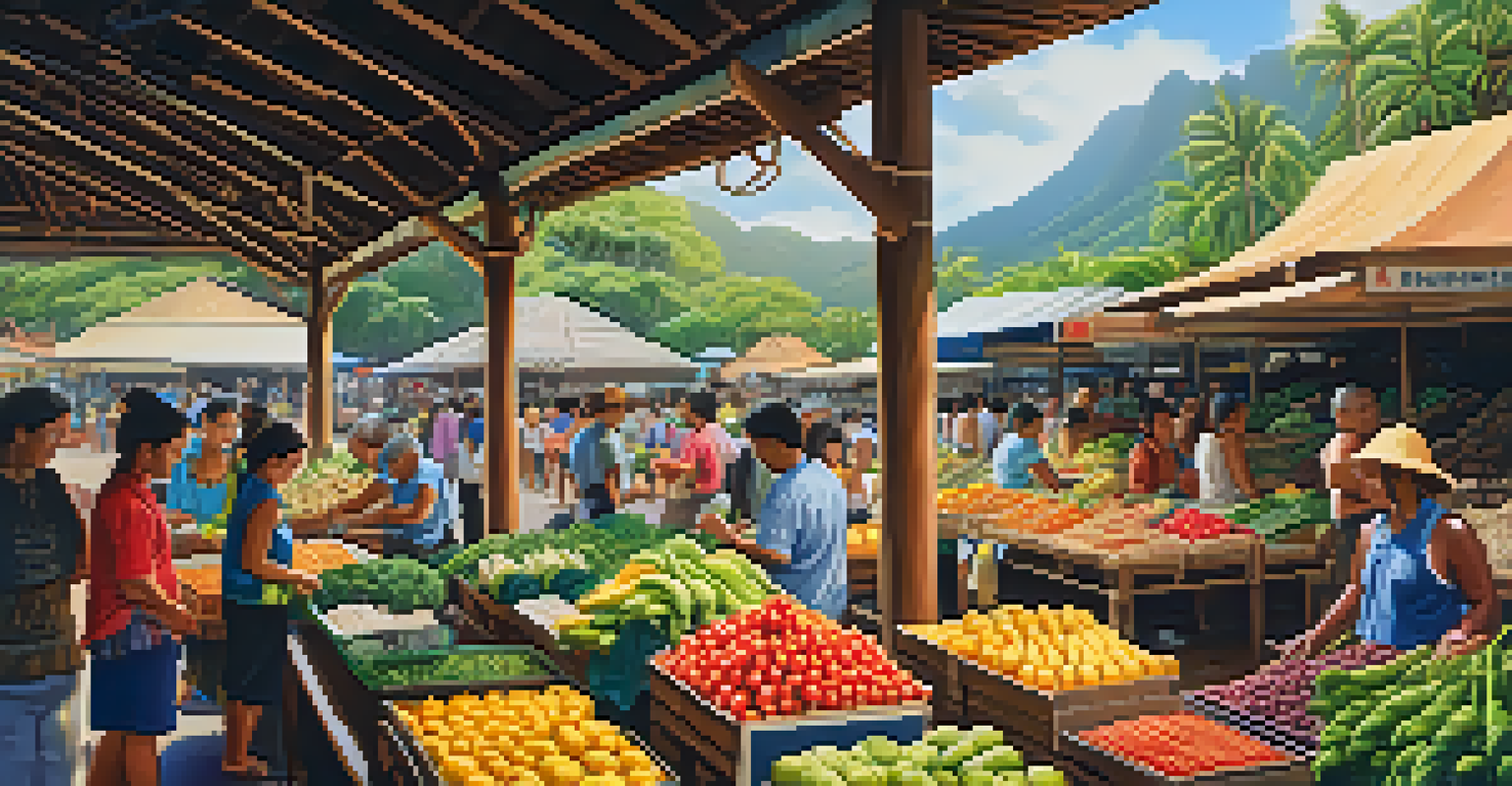The Origins of Hawaii's Trade Networks: A Historical Overview

Early Hawaiian Society and Its Needs
Before the arrival of Europeans, Hawaii was home to a complex society that relied heavily on trade. The islands’ natural resources were varied, yet specific items were scarce, leading to the need for trade among the islands. For instance, while some islands were rich in fish, others boasted fertile lands for agriculture. This interdependence shaped the early economic landscape of Hawaii.
Trade is a science that has the power to unite different cultures and foster connections.
Hawaiians developed a sophisticated understanding of their environment, which played a crucial role in their trade practices. They cultivated taro and sweet potatoes, which were staple foods, and exchanged these for other goods they needed. This mutual reliance not only fostered relationships between different island communities but also promoted a sense of unity across the archipelago.
Trade was not just about the exchange of goods; it was also a way to forge social and political alliances. This interconnectedness laid the groundwork for a vibrant trade network that would evolve over centuries, allowing Hawaiian society to flourish.
Navigating the Seas: The Role of Canoes
The double-hulled canoe, known as the wa'a, was a vital tool for Hawaiian trade. These canoes were designed for long-distance travel, enabling Hawaiians to navigate the vast Pacific Ocean with remarkable skill. Their construction allowed for both cargo and crew, making them ideal for transporting goods between islands.

Canoe voyages were often planned around the lunar calendar, demonstrating the Hawaiians' deep understanding of natural rhythms. Skilled navigators used stars, ocean swells, and bird behaviors to guide their journeys, showcasing an impressive blend of knowledge and tradition. This mastery of navigation not only facilitated trade but also strengthened cultural ties among the Hawaiian people.
Interconnected Trade Networks
Hawaii's complex trade networks facilitated economic interdependence among islands, fostering unity and cultural exchange.
As these canoes connected different islands, they became symbols of trade and communication. Each voyage represented more than just a journey; it was an opportunity for cultural exchange, where stories, practices, and innovations could be shared and celebrated.
The Influence of the Chinese and the West
The arrival of Chinese traders and Western explorers in the late 18th century marked a significant turning point for Hawaii's trade networks. Chinese merchants introduced new goods, such as silk and porcelain, which were highly sought after by Hawaiians. This influx of foreign products expanded the variety of items available for trade and influenced local tastes.
The greatness of a culture can be found in its festivals, traditions, and the interactions that shape its identity.
Western explorers, including Captain James Cook, also played a role in shaping Hawaii's economic landscape. Their visits brought new technologies and goods, but they also introduced challenges, such as diseases that devastated local populations. The interactions with these foreign powers ultimately altered the dynamics of trade in Hawaii, leading to both opportunities and obstacles.
Despite these challenges, the adaptability of the Hawaiian people allowed them to integrate new influences while preserving their cultural identity. This resilience laid the foundation for a more complex and diverse trade network that would continue to evolve in the years to come.
The Rise of the Sugar Industry
In the 19th century, Hawaii's economy underwent a significant transformation with the rise of the sugar industry. Sugarcane became a lucrative crop, attracting both investment and labor from various countries, including China and Japan. This influx of labor not only reshaped the agricultural landscape but also diversified the cultural fabric of Hawaii.
The sugar industry thrived on the export of raw sugar to markets in the United States and beyond. As plantations expanded, so did the need for infrastructure, leading to the construction of railroads and ports. This development further integrated Hawaii into global trade networks, enhancing its economic significance in the Pacific.
Canoes: Key to Navigation
The double-hulled canoe was essential for long-distance travel, enabling skilled navigators to connect the islands and share cultural practices.
However, the sugar boom also brought about social challenges, such as labor disputes and cultural tensions. These issues highlighted the complexities of trade and its impact on local communities, setting the stage for future changes in Hawaii's economy and society.
Trade Routes: A Web of Connections
Hawaii's trade routes formed a complex web of connections that extended across the Pacific. The archipelago served as a crucial stop for ships traveling between Asia and the Americas, enhancing its strategic importance. These trade routes not only facilitated the exchange of goods but also made Hawaii a melting pot of cultures and ideas.
As goods moved in and out of Hawaii, they carried with them stories and traditions from various cultures. This exchange enriched the local culture, leading to the incorporation of new practices and beliefs. For example, the introduction of new foods and agricultural techniques transformed Hawaiian cuisine, blending traditional flavors with new influences.
The evolution of these trade routes highlighted Hawaii's adaptability and resilience throughout changing global dynamics. Even as the world became more interconnected, Hawaii managed to maintain its unique identity within this web of trade.
Cultural Exchange Through Trade
Trade in Hawaii was not solely about economic transactions; it was also a powerful means of cultural exchange. Through trade, Hawaiians shared their customs, art, and language with various cultures, enriching their own heritage in the process. This exchange fostered a sense of community and understanding among diverse groups.
The introduction of foreign goods often led to new artistic expressions and innovations. For instance, the blending of traditional Hawaiian craft techniques with foreign materials resulted in unique art forms that celebrated both cultures. This cultural fluidity is a testament to Hawaii's ability to adapt while staying rooted in its traditions.
Cultural Exchange and Resilience
Trade not only enriched Hawaii's economy but also promoted cultural exchange, allowing the islands to adapt while preserving their unique heritage.
Moreover, the relationships formed through trade created lasting bonds between different communities. These connections helped to preserve Hawaiian culture, even as new influences emerged, ensuring that the essence of Hawaii remained vibrant amid change.
The Legacy of Hawaii's Trade Networks
Today, the legacy of Hawaii's trade networks can still be seen in its vibrant economy and diverse culture. The historical exchanges have left an indelible mark on Hawaiian identity, shaping everything from cuisine to art. Understanding this legacy helps us appreciate the intricate tapestry of influences that define modern Hawaii.
Hawaii's trade history also serves as a reminder of the importance of adaptability. As the world continues to evolve, the ability to embrace new ideas while honoring traditions remains crucial. This balance is evident in Hawaii's tourism industry, where cultural heritage and modern amenities coexist harmoniously.

Ultimately, the story of Hawaii's trade networks is a testament to resilience, innovation, and cultural richness. As we explore this history, we gain a deeper understanding of how trade has shaped not only Hawaii but also the broader Pacific region, creating connections that continue to thrive today.